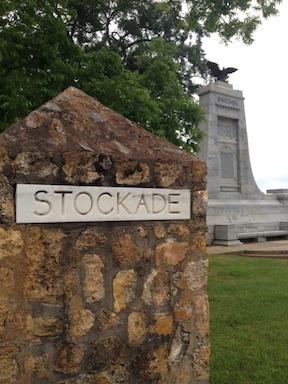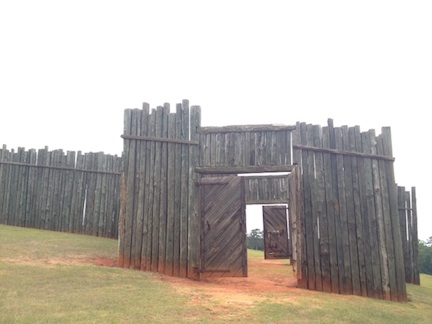Day Two: Andersonville
Two weeks ago, I discovered I had an ancestor who fought in the Civil War. This was big news for me because, according to family history on both sides, my ancestors were immigrants who came over from Ireland, Poland, and Slovania around the turn of the nineteenth century.
Apparently, though, a great-great-great grandfather on my mother’s side, Sheldon Appleby, served in a New York infantry regiment. In 1863, he (and much of the rest of the regiment) was captured at the battle of Suffolk and eventually found his way to Andersonville.
Today, I showed up at Andersonville to walk in my great-great-great grandfather’s footsteps.
Andersonville has been a Civil War bucket-lister for us for years, so we’ve been looking forward to this part of the trip the most. But now to know that I come here with some roots in the place, as infamous as the place is, gives the visit deeper resonance.
Steph just graduated with her bachelor of science in criminal justice, and during her course of study, she spent a lot of time studying prisons. So, she’s interested in today’s visit for that reason, too, beyond her Civil War interest.
For Dan, his wife’s great-great-great grandfather, Levi Bowen, also did time at Andersonville. He served with the 7th PA Reserves and was captured in the Wilderness.
So, we’re bringing lots of layers with us as we drive the ribbon of rural state highway away from Interstate 75. It takes us through acres and acres of pecan orchards. “So much for Georgia peaches,” I think. There are pecans in Georgia like there’s cotton in South Carolina—whole landscapes of it.
The pecans give way to Georgia pines, and finally, we find ourselves at Andersonville. The visitor center doubles as the National Prisoners of War Museum, which offers such a powerful visitor experience that I find myself crying by the time I’m done. (I’ll write about that visit in another post, at another time.)
Outside, beyond a POW memorial, a walkway leads to a reconstructed portion of the Andersonville stockade that sits on the northeast corner of the prison’s footprint. The prison itself totaled 26.5 acres—much too large to recreate in its entirely, especially with the double inner-and-outer walls—so the Park Service has recreated only two small sections.
It’s enough.
 Inside the reconstructed corner, makeshift tents—”shebangs”—cluster in cramped rows: blankets, canvases, scraps of salvaged clothes…anything that would provide some shade and shelter from the unforgiving Georgia sun.
Inside the reconstructed corner, makeshift tents—”shebangs”—cluster in cramped rows: blankets, canvases, scraps of salvaged clothes…anything that would provide some shade and shelter from the unforgiving Georgia sun.
There’s grass here now, but imagine the impact of 36,000 pairs of feet, pounding it down to dust. The red Georgia clay would make the ground looked stained with blood.
Built in January of 1864 as Camp Sumter to hold 10,000 prisoners, Andersonville quickly found itself overcrowded, and by June, extra space was added. A thin muddy trickle of water—Stockade Branch of Sweetwater Creek—ran through the middle. It was anything but sweet, though, since the soldiers also had their latrines near the water.
I’m surprised by the terrain, which rises up from either small bank of the creek to large hills on either side. I guess I’d always envisioned a wide, flat plain.
The area had been covered with a thick oak and pine forest in the 1860s. Slaves cleared the land and used the tree trunks as the prison walls, sinking them five feet into the ground. The walls rose 17 feet high.
Still, the lack of reconstructed walls along the perimeter works as an advantage, because it’s easy to see the expanse of the place. Maybe the lack of walls makes it feel more open, more vast, more unimaginably large. For those jammed in here, though, it felt like anything but.
A few survey markers dot the ground like chicken pox: locations of old wells and possible escape tunnels. Two trees are enclosed in iron fences, apparently to keep them from escaping down the old tunnels prisoners had dug at their roots.
 We decide to walk the entire perimeter of the stockade. Two lines of white posts mark the prison’s outline; one marks the stockade wall, the other marks the edge of the “deadline,” which ran nineteen feet inside the wall. Any prisoner who crossed the deadline and got too close to the wall would be shot dead.
We decide to walk the entire perimeter of the stockade. Two lines of white posts mark the prison’s outline; one marks the stockade wall, the other marks the edge of the “deadline,” which ran nineteen feet inside the wall. Any prisoner who crossed the deadline and got too close to the wall would be shot dead.
Our walk first takes us to a cluster of monuments in the northwest corner of the stockade. A common theme appears on many of them, here and in the national cemetery: “Dead before dishonor.”
From the monuments, we follow the curve of the hill down to the reconstructed prison gate: a big castle-like wooden box with cast iron fixtures and an aura of foreboding. Abandon hope, all ye who enter here.
Beyond, Providence Spring springs from the ground, runs along a beautiful rocky trough past some trees and into a rectangular reflecting pool before spilling into Stockade Branch. Nearby, a sign warns visitors of rattlesnakes. Keep out of the tall grass, it says.
“Do you think they had to worry about the snakes back then?” Steph asks.
“The snakes would be food, if they did.” What some of those guys would’ve given for meat of any kind, I imagine.
We see fire ants as we walk, too. Were there fire ants in this area back then? Was that one more misery the prisoners had to deal with? Ticks. Lice. Heat. Thirst. Disease. Overcrowding. Isolation from home.
Confederates captured some 126,950 POWs during the Civil War; Federals captured some 220,000. That totals 346,950 soldiers—more than were held in WWII.
Some 13,000 Federal prisoners died at Andersonville. That’s 40 percent of all Federal POWs who died while in Confederate custody. Andersonville’s dead were buried nearby in what has become Andersonville National Cemetery.
Those numbers made Andersonville notorious among all Confederate prisons. Its closest northern counterpart, the prison in Elmira, New York, had an equally grim reputation that earned it the nickname “Hellmira.” The site of that camp has been lost to a neighborhood over time, but Andersonville is all here, all open, all horrible in its emptiness.
We ascend the opposite hill and continue along the perimeter to the southwest corner, then over to the southeast corner. Then we close the circuit by walking the eastern leg. The whole time, I just can’t stop marveling at the size of the place.
 How intimately did Sheldon Appleby get to know this place? How long was he here? What did he look like when he got out?
How intimately did Sheldon Appleby get to know this place? How long was he here? What did he look like when he got out?
In the photo I have of him, he’s an old man with a big white bushy moustache, sitting in quiet dignity with his family around him. For a year, though, he lived in this red Georgia dust, with ticks and lice and other starving men from across the north.
Andersonville is no longer an infamous name or a bucket-list place to visit. Part of me comes from here because my great-great-great grandfather made it out of here alive.
I wonder what Sheldon would think were he able to come back today. I can feel him with me.

Excellent article Chris!
Chris,
I too understand the deep emotion felt when visiting Andersonville. Emotions unlike those felt at other Civil War sites.
What a legacy for your families… I had a 2grandfather who fought heroically with the 10th Mississippi, as well as owning slaves. I know his story continues with him adjusting well to post-war life, becoming a magistrate and sending a son from a 2nd wife to medical school. I was content to know he wasn’t like P
op O’Hara (Scarlett’s dad) and went beserk w/o the old southern paradigm. What a mess the southerners were with their ‘peculiar’ institution of slavery.